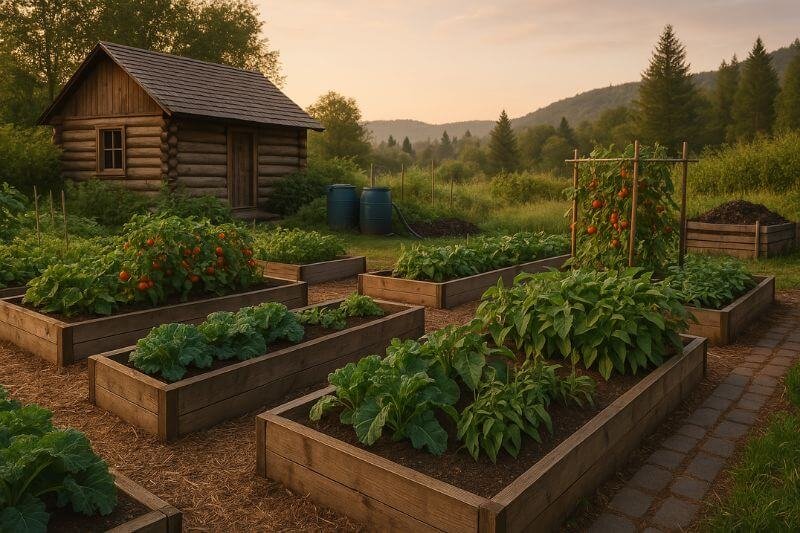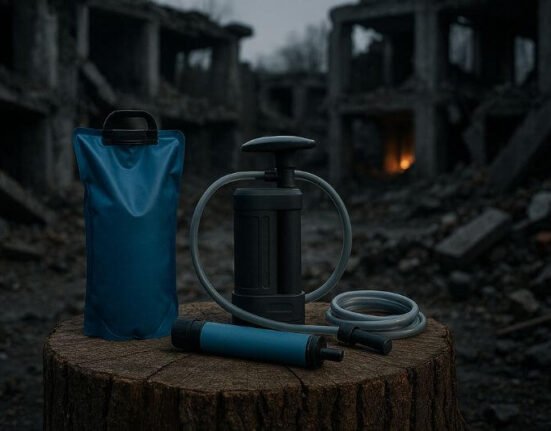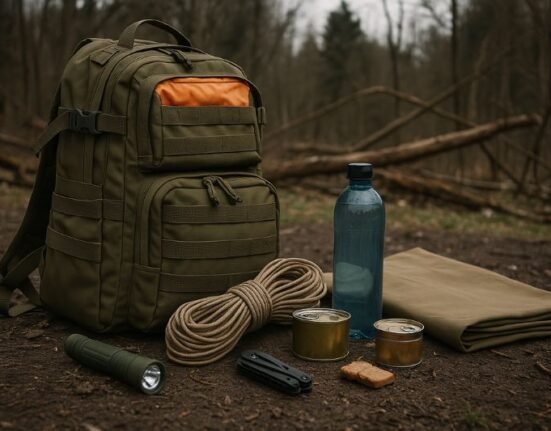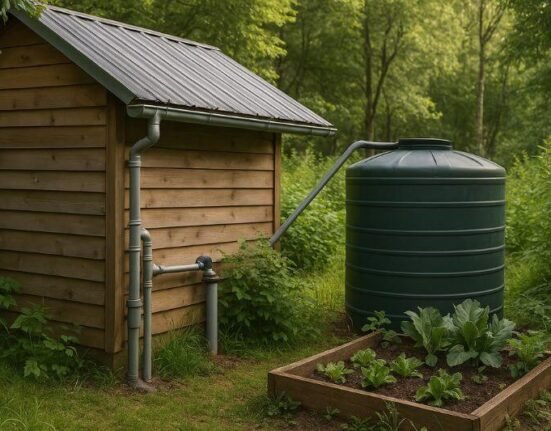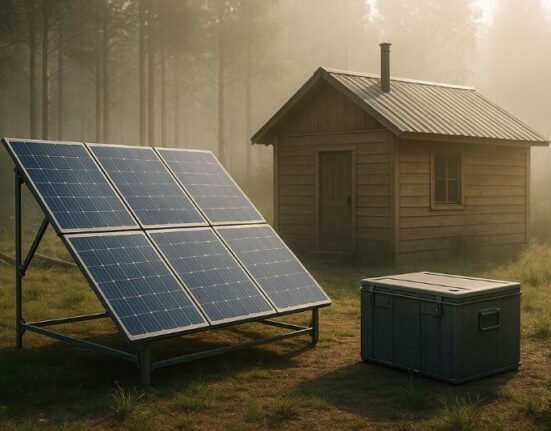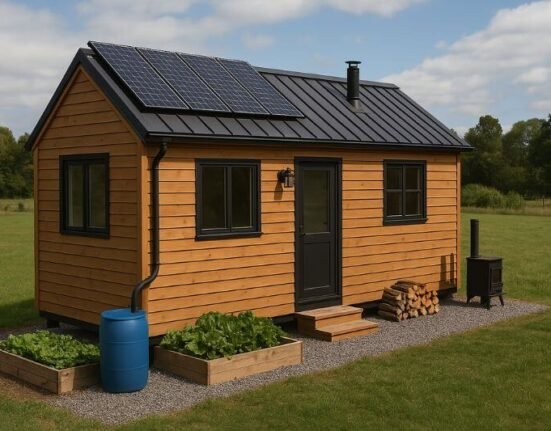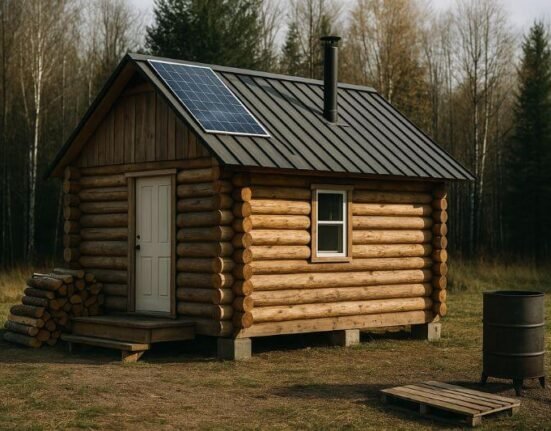In a survival scenario, food security isn’t about stockpiles — it’s about self-sufficiency. Whether you live in a mountain cabin, an urban rooftop, or a dry desert homestead, off-grid gardening empowers you to produce fresh, nutritious food year-round, without relying on unstable supply chains or fuel-based systems.
Done right, an off-grid garden becomes more than food — it becomes your medicine cabinet, barter tool, and mental sanctuary. And it all starts with one patch of soil, one seed, and the right survival mindset.
🧱 Part 1: Foundations of Off-Grid Gardening
🌍 Why Off-Grid Gardening Matters More Than Ever
If a disaster cuts power or fuel, your fridge dies in days. Your pantry empties in weeks. But your garden? It grows stronger every season — if you build it right.
Key benefits of off-grid gardening:
- Total independence from food supply chains
- Healthier, chemical-free harvests
- Seed saving = long-term sustainability
- Resilience in economic collapse, war, or environmental crisis
“Growing your own food is like printing your own currency — but more nourishing.” — Prepper Homestead Journal, 2024
📦 What Makes a Garden Truly Off-Grid?
An off-grid garden is fully independent of external systems:
- No city water or irrigation
- No electric grow lights or timed sprinkler systems
- No chemical fertilizers or pesticides
It relies on:
- Rainwater collection or hand-watering
- Natural sunlight
- Soil health and compost
- Human labor and recycled materials
It’s built for durability, regeneration, and adaptation — not convenience.
🌎 Choose Your Garden Location Wisely
Your space dictates your survival strategy. Whether you have acres of land or a few containers, every inch counts.
📍 Location checklist:
- 6+ hours of direct sun daily
- Access to water (stored, rainwater, greywater)
- Protection from wind, pests, and wildlife
- Near your living space (so you’ll actually tend to it)
- Good drainage and slope (avoid swampy zones)
🛑 Avoid areas near roads, septic leach fields, or contaminated soil.
💡 If space is limited, vertical gardening or raised beds with recycled containers are your best allies.
🧱 Raised Beds vs. In-Ground: Which is Better?
| Feature | Raised Beds | In-Ground Gardening |
|---|---|---|
| Setup Cost | Higher (lumber, soil, frame) | Lower (just soil prep) |
| Soil Control | Excellent | Dependent on native soil |
| Pest Defense | Easier to protect | Harder to control burrowers |
| Mobility | Medium | Permanent |
| Water Needs | Dries faster | Holds water longer |
Off-gridders often start with raised beds for control, then expand in-ground when resources grow.
🌿 Soil is Everything
Forget fertilizers — if your soil is dead, your garden fails. Healthy soil retains water, hosts life, and feeds plants naturally.
Off-grid soil boosting strategies:
- Compost (from kitchen scraps, toilet compost, garden trimmings)
- Worm castings (vermiculture)
- Wood ash (raises pH, adds potassium)
- Crushed eggshells (calcium)
- Mulch (keeps soil moist and alive)
🧪 Test your soil pH using a cheap kit or vinegar/baking soda trick. Adjust with lime (to raise pH) or sulfur (to lower).
🪴 What Can You Grow Off-Grid?
Start with what’s easy, calorie-dense, and resilient:
Top 10 beginner crops:
- Potatoes
- Beans (bush or pole)
- Kale or collards
- Tomatoes
- Zucchini
- Carrots
- Garlic
- Onions
- Squash
- Herbs (mint, oregano, thyme)
🌾 Bonus: Learn to grow seed-saving crops like tomatoes, lettuce, beans, and peppers — this closes the loop.
🧠 Smart Garden Design for Off-Grid Success
Plan for zones of accessibility and resource use. Think permaculture — everything should serve more than one purpose.
Include:
- Compost area near the garden
- Rain barrel connected to roof or gutter
- Tool cache (shovel, hoe, trowel, netting)
- Fence or natural barrier (to keep out animals)
- Paths made of mulch or gravel
💬 A good rule: if it’s hard to access or maintain, you won’t. Keep it close and simple.
🛠️ Part 2: Building and Managing Your Off-Grid Garden
🔨 Step-by-Step: Building Your Off-Grid Garden from Scratch
🧰 Materials You Can Salvage:
- Pallets or scrap wood → Raised beds
- 5-gallon buckets or barrels → Containers
- Chicken wire → Pest fencing
- Window screens → Shade cloth or seed dryers
- Cinder blocks → Bed borders or planters
Step-by-step setup:
- Choose your sunniest, flattest location
- Build beds (in-ground or raised)
- Add compost, manure, topsoil
- Mulch deeply (hay, straw, leaves)
- Add trellises for vertical crops
- Place rain barrels or greywater barrels nearby
“Think modular. You don’t need a full garden in one day — just one productive bed to start growing.” — Survival Garden Blueprint, 2023
💦 Off-Grid Watering Systems
Water is your most limited asset off-grid. You must capture and conserve every drop.
✅ Methods that work:
- Rainwater barrels with gravity-fed drip lines
- Ollas (clay pots buried in soil that slowly seep water)
- Wicking beds with reservoirs at the bottom
- Greywater from washing (filtered before use)
🛑 Avoid overhead sprinklers. They waste water and promote disease.
💡 Tip: Water before sunrise or after sunset to minimize evaporation.
🐛 Natural Pest & Disease Control
Forget chemical sprays. Your goal is balance, not eradication.
🌱 Prevention:
- Rotate crops yearly
- Mulch to block weed seeds
- Choose disease-resistant heirloom seeds
- Space plants for airflow
🐜 Natural solutions:
- Diatomaceous earth = kills crawling insects
- Neem oil = repels aphids and mites
- Garlic spray = fungicide and insect deterrent
- Chickens or ducks = slug and beetle patrol
“Insects don’t destroy gardens — imbalanced ecosystems do.” — Off-Grid Plant Defense Field Notes
🌿 Companion Planting: Nature’s Smart Defense
Certain plants boost each other’s growth and health. Use them to your advantage.
| Plant | Companions | Avoid Planting With |
|---|---|---|
| Tomatoes | Basil, marigolds | Potatoes, corn |
| Beans | Corn, squash | Onions, garlic |
| Carrots | Onions, lettuce | Dill |
| Cabbage family | Celery, onions | Strawberries, tomatoes |
💡 Marigolds deter nematodes and aphids — always plant a few in every bed.
🪴 Vertical Gardening for Tight Spaces
When land is limited, grow up — not out.
Best plants for vertical growth:
- Pole beans
- Peas
- Cucumbers
- Squash
- Tomatoes (staked or caged)
✅ Use salvaged materials:
- Old ladders
- Trellises from sticks
- Wire fencing
- Hanging pots on walls
“One fence covered in cucumbers feeds a family for weeks. Vertical is survival math.” — Urban Survival Garden Guide
🧑🌾 Example Setup: Micro Homestead Garden in New Mexico
Rosa and Miguel, living fully off-grid in New Mexico, grow 80% of their food in a 10×20 ft space.
- Raised beds built from adobe bricks
- Rainwater tanks fed by gutter catchment
- Wicking beds for tomatoes and squash
- Straw mulch protects soil from heat
- Companion planting: basil + tomatoes, carrots + onions
💬 “Our garden needs no fuel, no chemicals, and no grid — just sun, seeds, and effort.”
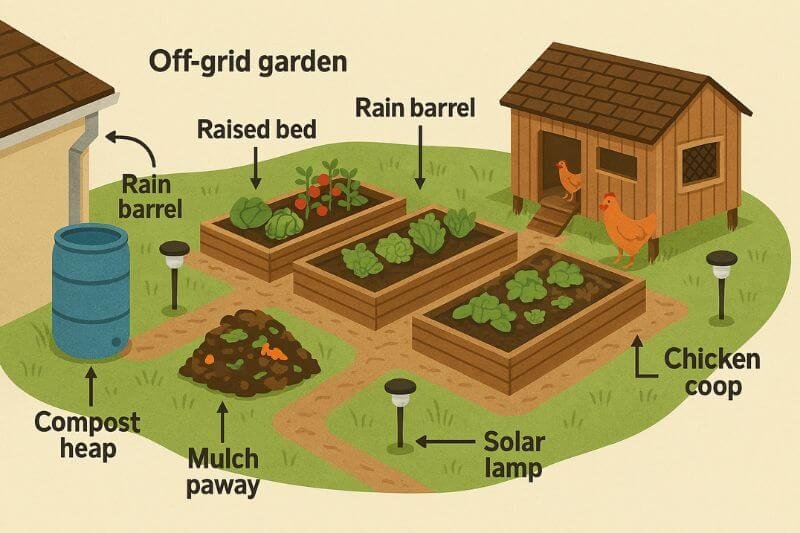
🌾 Part 3: Sustainability, Survival Strategies, and Year-Round Off-Grid Gardening
🌱 Seed Saving: The Key to True Self-Reliance
In off-grid gardening, relying on store-bought seeds is a vulnerability. Learning to save your own seeds creates a closed-loop system that can last generations.
🪻 Easiest Crops for Beginners:
- Tomatoes
- Peppers
- Beans (dry thoroughly)
- Lettuce
- Cucumbers (let them fully ripen first)
✅ Store in paper envelopes in a cool, dry place. Label with date and variety.
💡 Tip: Save seeds from your strongest, healthiest plants — they carry the best genetics for your microclimate.
“Seed sovereignty is food sovereignty.” — Heirloom Survival Network, 2024
🔁 Crop Rotation & Soil Recovery
Soil fatigue is real. Repeating the same crop in the same place encourages pests and nutrient depletion.
🔄 3-Year Crop Rotation Model:
- Leafy crops (lettuce, spinach, kale)
- Fruit crops (tomatoes, squash, peppers)
- Root crops (carrots, beets, radishes)
- Legumes (beans, peas — to fix nitrogen)
Bonus: Add a season of green manure or cover crops like clover to rebuild fertility.
🧊 Gardening Year-Round: Winter Doesn’t Mean Starvation
Even in cold climates, you can keep growing food off-grid with low-tech strategies.
🔥 Tools for All Seasons:
- Cold frames (wood + clear lid) to extend fall growing
- Mini greenhouses (PVC + plastic sheeting)
- Cloche domes (cut water jugs or glass covers)
- Indoor sprouts (alfalfa, mung beans, sunflower)
✅ Greens like kale, mache, and spinach can survive under snow with the right protection.
“Winter doesn’t kill your garden. Lack of planning does.” — Northern Survival Gardener
⏱️ Emergency Gardening: Fast Crops in a Crisis
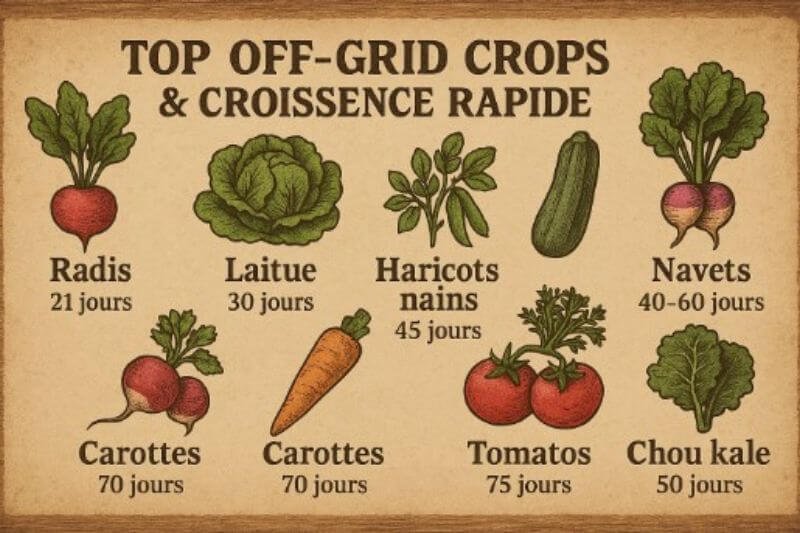
When time is short and food is scarce, focus on crops that deliver fast calories.
🥕 Fastest-Growing Off-Grid Crops:
| Crop | Harvest Time | Notes |
|---|---|---|
| Radishes | 21–30 days | Plant every 2 weeks |
| Lettuce | 30 days (baby) | Cut-and-come-again friendly |
| Bush Beans | 45–50 days | Good protein + calories |
| Zucchini | 45 days | Heavy yield in little space |
| Turnips | 40–60 days | Roots and greens edible |
💡 Use containers or recycled bins if ground is poor or unavailable.
🧠 Psychological and Barter Value of Gardening
Your garden feeds more than your stomach.
- Mental health: Gardening reduces stress, builds purpose, and restores rhythm
- Barter: Fresh produce becomes a tradeable asset post-collapse
- Education: Teaching others how to grow is as valuable as food itself
🧺 A full harvest basket can mean food, friendship, or survival leverage.
❓ Frequently Asked Questions (FAQ)
Q: How much space do I need to grow food for one person?
This is one of the most common questions for new preppers or off-grid homesteaders — and the good news is: you need less space than you think, if you plan intelligently.
With proper layout and crop selection, 100 to 200 square feet of cultivated space per person can supply:
- Most of the annual need for vegetables
- A significant portion of daily nutrients
- Minimal dependence on external supply chains
However:
- If you plan to grow staple calorie crops like potatoes, squash, corn, or legumes — budget 300–400 sq ft per person.
- For grains (wheat, oats, quinoa), you’ll need even more — over 1000 sq ft per person — and specialized processing tools.
✅ Best approach: Start with diversity and density, then scale up once you master composting, rotation, and water cycles.
“One 4×8 ft bed can yield over 80 lbs of food a year if well-managed. Multiply that by 3–4 and you’re already feeding yourself.” — Off-Grid Garden Planner, 2023
Q: Can I grow food off-grid indoors?
Yes — indoor gardening is not only possible, but highly useful during:
- Winter months
- Urban or space-limited survival settings
- Stealth prepping (urban collapse scenarios)
✅ Strategies that work without electricity:
- Use south-facing windows for passive sunlight
- Grow in containers like buckets, basins, or window boxes
- Set up vertical racks for herbs and sprouts (spin them daily for even light)
- Use reflective surfaces (aluminum foil, white walls) to boost light diffusion
🪴 Ideal indoor crops:
- Microgreens (ready in 7–10 days)
- Lettuce, arugula, mustard greens
- Herbs: basil, parsley, thyme, oregano
- Dwarf tomatoes and peppers
⚠️ No need for artificial grow lights if you have adequate natural light — though solar-powered grow lights can be added if necessary.
“With just one window, five pots, and a water jug, I kept greens and herbs flowing all winter. That’s survival from the sill.” — Jade L., Cabin Preparer, Canada
Q: What tools do I need for an off-grid garden?
You don’t need a full shed of gear. A minimalist, durable toolset will take you a long way.
🎒 Essential survival gardening tools:
- Hoe – for breaking and shaping soil
- Hand trowel – for planting, transplanting
- Pruners/shears – for trimming and harvesting
- Buckets – for water, compost, harvest, and mixing
- Watering can or gravity-fed bottle system
- Seed packets (plus saved seeds)
- Compost pile or bin
- Mulch stockpile (straw, leaves, cardboard)
✅ Bonus gear (optional but smart):
- Spare trowels and shears (in case of breakage)
- Sharpening stone
- Wire mesh (pest protection, DIY trellising)
- Folding solar oven (to sterilize soil or cook food)
💬 Always think redundancy and barter: an extra shovel is worth more than silver in a collapsed economy.
Q: Can I grow food in sand, clay, or poor soil?
Absolutely. Even the worst soil can become productive with the right off-grid strategies.
🧱 Soil solutions by type:
- Sandy soil: drains too quickly → Add compost, biochar, and clay dust
- Clay soil: holds too much water → Add sand, aged manure, and perlite
- Rocky soil: dig raised beds or use hugelkultur mounds (logs + compost layered)
- Urban soil (polluted): grow in containers or raised beds with imported organic soil
🔁 Compost is your long-term fix:
- Breaks up clay
- Holds moisture in sand
- Feeds microbes and roots
- Detoxifies many contaminants over time
“Compost turns dirt into soil, and soil into life.” — Soil Resilience Handbook, 2024
✅ Conclusion: The Garden Is Your Lifeline
Off-grid gardening isn’t just a hobby — it’s a strategic survival system. Whether you’re preparing for grid failure, economic collapse, or long-term self-sufficiency, a thriving garden gives you control over your most vital resource: food.
Start small. Observe. Learn. Adapt.
And above all, grow — no matter where you are.
💬 “If you own seeds and know how to grow them, you will never be hungry again.”









